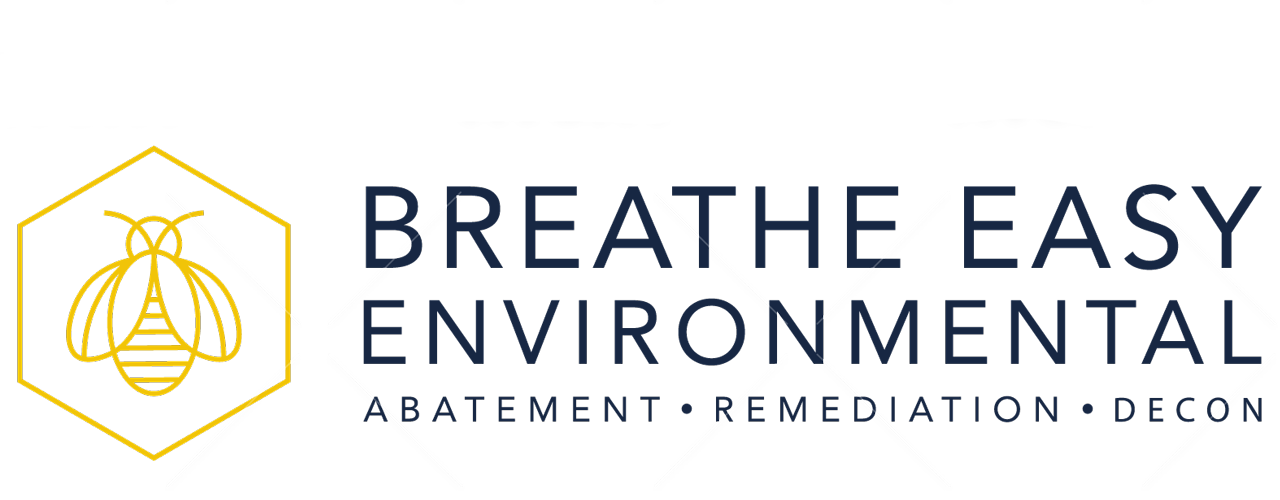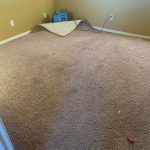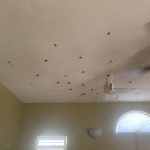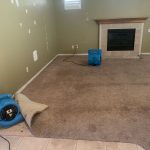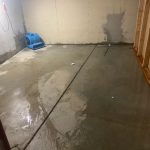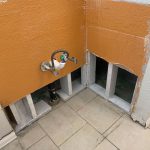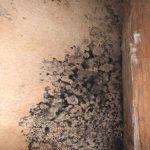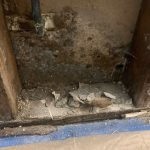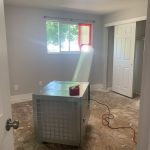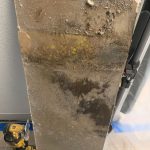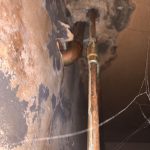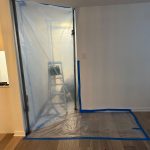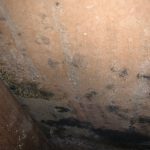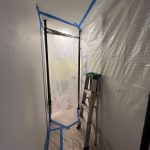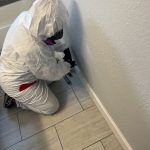Safe Water Damage & Mold Removal
Hidden mold in your home or property can have dangerous effects on the health of your family or tenants. Mold is sometimes called “the silent killer” because it can make people sick without them realizing it is the cause of their sickness. When visible, it is easy to spot, and also emits a musty odor. But mold can also grow behind walls, in attics, or other unseen corners of the home and then spread through HVAC systems.
Symptoms of mold irritation can include sneezing, wheezing, coughing, difficulty breathing, and skin rashes. If people have prolonged exposure, it can result in very serious illness.
Mold often forms where there is excessive moisture and lack of ventilation to dry dampness out. In homes, this often happens due to leaky roofs or pipes, flooded toilets, broken/cracked water lines, sump overflow, and more.
Signs and Symptoms of Mold Exposure
Mold irritation resulting from water damage can manifest in various ways, affecting both your property and your health. Identifying these signs early can help you address the problem promptly and prevent further damage or health issues. Better With Bee can help contain and remove mold in your home.
Property-Related Signs
- Musty Odor:
- A persistent, musty smell is often one of the first indicators of mold growth. This odor is caused by the volatile organic compounds (VOCs) released by mold as it grows.
- Visible Mold Growth:
- Mold can appear as black, green, white, or even orange patches on walls, ceilings, floors, and other surfaces. It often grows in damp, dark, and hidden areas such as behind drywall, under carpets, in basements, and crawl spaces.
- Water Stains and Discoloration:
- Water damage often leaves behind stains or discoloration on walls, ceilings, and floors. These stains can indicate where mold may be growing.
- Peeling or Bubbling Paint and Wallpaper:
- Excess moisture can cause paint and wallpaper to peel or bubble. This is often a sign of water damage and potential mold growth behind the surfaces.
- Warped or Buckling Floors:
- Moisture from water damage can cause wooden floors to warp or buckle. This can create gaps or uneven surfaces, indicating a potential mold problem.
- Deterioration of Building Materials:
- Materials like drywall, wood, and insulation can deteriorate due to prolonged exposure to moisture and mold. This can weaken the structural integrity of your property.
Health-Related Symptoms
- Allergic Reactions:
- Common symptoms of mold allergies include sneezing, runny or stuffy nose, itchy or watery eyes, and skin rashes. These symptoms are often more severe in individuals with mold allergies.
- Respiratory Issues:
- Mold spores can irritate the respiratory system, causing coughing, wheezing, shortness of breath, and chest tightness. People with asthma or other respiratory conditions may experience exacerbated symptoms.
- Sinus Congestion:
- Chronic sinus congestion and sinus infections can occur due to mold exposure. This can lead to headaches, facial pain, and pressure.
- Eye Irritation:
- Exposure to mold spores can cause red, itchy, or watery eyes. This irritation is similar to allergic reactions and can be particularly bothersome for individuals with sensitivities.
- Skin Irritation:
- Direct contact with mold or mold spores can cause skin irritation, rashes, and itching. This is especially common in people with sensitive skin or mold allergies.
- Fatigue and Malaise:
- Prolonged exposure to mold can lead to fatigue, malaise, and a general feeling of being unwell. This can impact daily activities and overall quality of life.
- Headaches:
- Frequent headaches or migraines can be a symptom of mold exposure, often due to inhaling mold spores or being in a mold-contaminated environment.
- Worsening of Pre-Existing Conditions:
- Individuals with pre-existing health conditions such as asthma, chronic obstructive pulmonary disease (COPD), or weakened immune systems may experience worsened symptoms and increased health risks due to mold exposure.
Better With Bee provides expert mold containment and removal services to ensure your home is safe and healthy. Our team uses advanced techniques and equipment, including HEPA air filters and thorough sanitation, to effectively contain and remove mold, improving indoor air quality and preventing future growth.
Categories of Damaging Water:
- Category 1: Clean Water — Originates from a clean source but can degrade in a relatively short time (i.e., within 48-72 hours on a wet carpet).
- Category 2: Grey Water — Contains a significant level of contamination, can cause discomfort or sickness, carries microorganisms and nutrients for microorganisms, and has potential to turn into Black Water if untreated for longer than 48 hours.
- Category 3: Black Water — Contains pathogenic agents and is extremely unsanitary, such as toilet back flow from beyond the tap, and other ground water flooding.
Typically, molds that colonize in water damaged structures take about 3-10 days to grow, so it’s important to dry water within 48 hours. If you see small patches of mold (i.e., less than a few square feet) you can safely remove it with certain over-the-counter cleaners or a simple bleach/water combination). However, if you have large deposits of mold in your home or office building, it’s extremely important to have it professionally removed. In some instances, this will literally save lives.
What does mold remediation entail?
Mold remediation is a multi-step process that requires proper safety precautions to avoid direct contamination, and proper waste disposal to avoid contaminating others.
1) Applying antimicrobial agents. – Antimicrobials prevent mold growth from occurring until the wet area is dried out and can also kill existing mold spores when present.
2) Identifying the source. – We identify all areas where mold may be growing or has the potential to grow through the use of state-of-the-art moisture detection equipment and inspection tools such as thermal imaging.
3) Containing the mold. – Once the source of moisture intrusion has been repaired, our technicians isolate the contaminated areas to eliminate the spread of mold spores to other areas.
4) Filtrating the air. – During the process of mold removal, spores can be disturbed and become airborne, requiring the use of HEPA air filters to clean the air throughout the project.
5) Removing and cleaning up mold. – In most cases, the most effective way to ensure proper mold remediation is to eliminate affected materials completely, often including drywall, insulation, wood trim, carpet, and even furniture.
6) Replacing affected materials. – We provide restoration services and repair affected areas with new materials, returning the property to a pre-loss condition.
Working with Breathe Easy Environmental
If you suspect mold in your Denver property, it is crucial to hire a professional for effective mold remediation to ensure the safety and health of your family or tenants. Most home insurance policies cover mold claims if the growth results from a sudden or accidental covered peril, such as a plumbing leak or flood. Bee’s Restoration offers competitive mold removal services and will work with your insurance to manage costs. We provide comprehensive mold mitigation, including indoor mold inspection, black mold removal, and crawl space encapsulation. Our mold remediation services are designed to enhance indoor air quality and prevent further contamination. Contact us today to learn more about our services and protect your property from mold damage.
3409 S. Zuni St.
- Englewood, CO 80110
- 720-318-5015
- Mon-Fri 8am-6pm
View our client testimonials!
Frequently Asked Questions About Water Damage & Mold Removal with BWB
Common causes of water damage in Denver homes include plumbing failures, roof leaks, flood events, and issues with the sanitary sewer system. Stormwater and natural disasters can also contribute to water damage. Homeowners should ensure proper water supply and waterproofing to prevent such occurrences.
Mold growth occurs when moisture from water damage remains unchecked, creating an ideal environment for mold spores to thrive. Indoor mold can cause health issues such as allergies, asthma, and respiratory infections. It’s crucial to address moisture and humidity promptly to prevent mold damage and safeguard indoor air quality.
The water extraction process involves several key steps: first, an inspection to assess the extent of the water damage; then, using pumps and vacuums to remove standing water. Dehumidifiers and air movers are employed to dry the area thoroughly, followed by carpet cleaning and drywall repair if necessary. Ensuring all water is extracted prevents further damage and mold growth.
Property managers should look for signs of water damage such as water stains on ceilings and walls, a musty odor indicating mold presence, warped or buckling floors, and visible mold growth. Other indicators include high humidity levels, mildew, and unexplained increases in water bills. Regular inspections and maintenance of plumbing, roofs, and drainage systems can help identify and address water damage early.
Crawl space encapsulation involves sealing the crawl space with a vapor barrier to prevent moisture intrusion. This process helps in maintaining lower humidity levels, reducing the risk of mold growth, and protecting structural elements like wood and drywall from water damage. Encapsulation also improves indoor air quality and can enhance the energy efficiency of the home.
Using reclaimed water and practicing water conservation methods can help in preventing water damage by reducing the strain on water supply systems and minimizing the risk of leaks and overflow. Reclaimed water can be used for irrigation, reducing the need for fresh water. Water conservation techniques, such as installing low-flow fixtures and repairing leaks promptly, help in maintaining water quality and preventing potential water damage.
Homeowners should immediately contact a water restoration company for emergency services. Steps include turning off the water supply to prevent further leakage, moving furniture and belongings to a dry area, and starting water extraction and drying processes. Prompt action can minimize damage, reduce the risk of mold growth, and improve the chances of successful water damage restoration. Engaging with a general contractor for any necessary repairs and ensuring proper ventilation are also critical steps.
